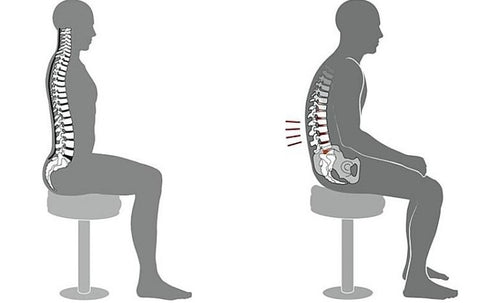After reading the first article in this series, you have now chosen your perfect seat and the necessary supports.
But these will not guarantee pain-free sitting until you understand how to position your hips, lower back, shoulders and neck. Your meditation posture is crucial. It often dictates how you meditate.
The following steps will help you to achieve a better meditation posture. Take your time and give yourself a few weeks for the body to adjust. Ask a friend to take a picture and check your alignment.

UNDERSTAND YOUR SPINE
You may already know this, but the spine has a natural curve. In his Bhagavad-Gita commentary, Paramahansa Yogananda calls this ‘Arjuna’s bow’ because it is curved at the lumbar, where the manipura chakra is located. The element of this chakra is fire and it correlates with Arjuna as the warrior of self-control and discipline. This point of the spine holds the back in a straight position allowing for the subtle energies to flow. This determination is essential.
This position of the spine, curved in the front and not in the back, is called “the bow of meditation,” well strung and ready for the battle with the senses! -Paramahansa Yogananda, Bhagavad-Gita Commentary I:22 (p. 127)

STRETCH A LOT AND SIT TALL
Did you know that within the spine is a flexible tissue that grows and shrinks? This is why the spine gets compressed during a day of sitting, and it gets even worse with poor posture. When you sleep, the spine can relax and stretch out again.
For this reason, stretching is very important. Paramahansa Yogananda taught the Yogoda Exercises (now known as the Energization Exercises) which help the spine—but he also recommended hatha yoga and other stretching exercises for the spine.
And throughout the day when you sit, try to sit tall and elongate the spine by imagining that someone is gently pulling the top of your head straight upward.
BUTTOCKS: YOUR NATURAL CUSHION
The buttocks are a natural cushion, but just like any pillow, they need some adjustments. Try this out and feel the difference: With your hands, pull back your buttocks so that your weight is on the front of your seat rather than sitting on top of or on back of your buttocks. This helps your pelvis position properly so that the rest of your spine reaches its natural curve. Once you get used to this, you’ll be able to “walk back” your buttocks without using your hands.
Of course it is highly recommended to use a wedge cushion or crescent cushion to further help with the proper 'base' of your meditation posture. (Have a look at our meditation cushions.)
“SHOULDERS BACK” — WHAT DOES THAT ACTUALLY MEAN?
In SRF we are told the usual drill about posture: “Feet flat on the floor, spine straight, shoulders back, chin parallel to the floor, gaze gently lifted to the point between the eyebrows…” and so on. As a monk in the SRF ashram, I would attend the optional 6-hour meditation on Sundays. My posture was perfect, or so I thought. I knew something was off when I started to feel pain in my upper back, shoulders and neck. Several other of my friends who were much older than me were feeling similar pain. So we researched some methods in relieving back pain discovered by progressive doctors, such as Esther Gokhale. We realized that we were doing it all wrong—the “shoulders back” part caused us much of the trouble.
These days, it seems everyone’s shoulders hunch forward. The amount of time we spend on a computer, or a desk, or a phone, or driving a car all require our head to look downward or our hands to be in front of us for long periods of time. What’s worse is that we stay in these positions with lots of tension and concentration for very long periods of time without changing our movement patterns. This creates a unique kind of tension that sets up a chronic pattern that in turn affects our everyday posture.
To counter this, do the following exercise before meditation (and try to do this throughout the day when you’re sitting).
THE SHOULDER EXERCISE
This exercise was a life changer for me because most of my tension during meditation would build around the upper shoulders and neck.
- Sit straight.
- Slowly rotate the neck in circles 3 times in each direction, taking full breaths.
- Do 3 shoulder rolls forward and backwards with deep breaths.
- Sit in your natural posture with straight spine.
- Inhale and lift shoulders straight up to your ears.
- Holding your breath, pull the lifted shoulders straight back and allow your hands and arms to follow backwards as well.
- Open chest
- Exhale and let your shoulders drop straight down with the pull of gravity. Feel the relaxation.
- Repeat this 3-5 times.
What this is doing is actually resetting your shoulder joint in it’s proper place. What I had been doing for years was pulling my “shoulders back” using my back muscles. This required so much tension that after an hour I was in pain. Rather than pull back, lift up, roll back and drop. This sets the shoulder in place without tension.

LEVEL HEADED AND SERENE
Chin “parallel to floor” is not so literal—it simply means to neither look upwards to the sky, nor to let the head droop downwards (which leads to sleeping). Usually you don’t even know what parallel is unless someone takes a picture of you when you are in meditation. Most people are either looking upwards, as if by tilting the head up to the sky they will see something new; or they go to the other extreme of drooping a bit downwards, which so often is a precursor to sleep.
The facial expression is also important. While the gaze of the eyes are lifted to the point between the eyebrows, the rest of the face should not be crunched up with tension. It’s meditation, not an exam. So, the face muscles should be relaxed and, as Yoganandaji would say, with a serene expression. I often think of it as the expression I make when I close my eyes and feel a cool and fragrant breeze blow over my face on a warm spring day.
What I've told myself is "be level headed and serene"!
IN REVIEW:
- Adjust Your Buttocks: Pull buttocks back and feet flat on the floor (or cross legged)
- Sit Tall: Elongate the spine by imagining that someone is gently pulling the top of your spine straight upward.
- The Bow of Meditation: Feel the natural curve of your lumbar and allow those muscles to relax. Your body knows what to do, just allow.
- Roll Back Shoulders: You will feel the shoulders are naturally back rather than pulled back with tension.
- Chest Open: This gives room for the lungs to breathe deeply.
- Level Headed: Chin neither too high or too low.
- And serene! Facial expression is relaxed and serene with slightly upward gaze.
Next article is on Malas, or meditation beads. Does a yogi need them? What kinds of beads are the best? How to count on them? and more!







Comments
Aug 22, 2019
Marianne J Ellis
This article was very helpful. Furthermore, while reading it, I made adjustments to the way I was sitting in front of my computer.Aug 22, 2019
Tessa Partridge-Mather
Yes! These are great suggestions :)